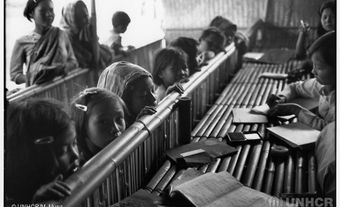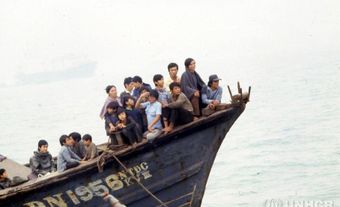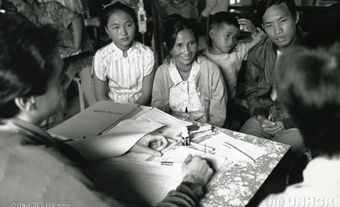French in the West
The French came to the North-West from Montréal in search of furs and an overland route to the Mer de l'Ouest which would lead to a short route to China (see coureurs de bois). While working for the Hudson's Bay Company, with headquarters in London, England, in 1682 Pierre Radisson explored 300 km inland from the bay.
Although the French had been established in the West (the Upper Great Lakes region) by the 1690s, their founding of fur-trading posts further west in the Winnipeg Basin occurred in the 1730s through the efforts of Pierre La Vérendrye and his sons. After the Conquest (1760), French traders in the West worked for the North West Company and the HBC, aiding in the expansion of the fur trade to the shores of the Arctic and Pacific. The first white woman to live in the West was Marie-Anne Lagemodière, the wife of a fur trader.
Birth of the Métis Nation
From the time of contact with the native population, many French traders married native women, producing a distinct group of "mixed-blood" or Métis. The Métis fought for the NWC against HBC at the battle of Seven Oaks in June 1816 at Red River. Piere Falcon's song about that victory reinforced their sense of common identity; the Métis nation was born.
Two years later Fathers Joseph Norbert Provencher and Sévère Joseph Nicolas Dumoulin reached the Red River Colony. In 1844 the diocese of the Red River became the Apostolic Vicariate of the North-West under Father (later Bishop) Provencher's guidance. The arrival of the Grey Nuns in 1840s strengthened the Christian faith and French culture of the Métis.
Early Economy and Settlement
By midcentury the Red River Métis had developed an economy based on the buffalo hunt, small-scale farming and seasonal labour for HBC. Many Métis also moved further west in search of buffalo; they settled at the forks of the Saskatchewan River and the Cypress Hills area of Saskatchewan and Lac Ste Anne and later, at St Albert near Fort Edmonton. By 1845 Bishop Provencher had persuaded the Oblates in France to send missionaries; one of the first to arrive was Alexandre Taché, who later recruited Father Grandin. Grandin, with Father Albert Lacombe, helped found the Catholic Church in what is present-day Alberta. By the 1850s the Oblates had also moved into BC, establishing missions along the south coast and the Okanagan and Fraser valleys.
When Canada acquired the Northwest, the Red River leader Louis Riel led a resistance movement that demanded a say in terms of union. Manitoba, carved out of Rupert's Land and the North-West Territories, entered Confederation as a reflection of Québec. Manitoba was created as a bilingual and bicultural province with a dual school system and a bicameral Legislature. Likewise, in Rupert's Land and the NWT, Dominion legislation in 1875 and 1877 had officially established a dual school system and bilingualism as in Québec (see Manitoba Act). Within a decade these measures came under attack as the large influx of English-speaking immigrants altered the ethnic structure of the west. An armed uprising led by Riel was quashed at Batoche in 1885, and Riel was hanged for treason in November 1885 (see North-West Rebellion). Riel's execution further divided the new Dominion along ethnic and religious lines.
In 1890 the Manitoba legislature passed an Act abolishing official bilingualism and depriving Catholics of their publicly funded schools (see Manitoba Schools Question). The Laurier-Greenway compromise of 1897 allowed for a limited teaching of the Roman Catholic faith and the teaching of French under certain conditions. In 1916 the Manitoba government made teaching in English mandatory, signalling the end of the French schools until the 1970s.
By 1892 in the North-West Territories, the dual school system was abolished, but Catholic schools were allowed under specific conditions. The territorial legislature also thought it had abolished the use of French in debate. These measures with respect to education and language were carried forward and became subject to the control of the legislatures of the 2 newly created provinces of Alberta and Saskatchewan in 1905. The French Canadians in Québec, who considered the West part of their heritage, were now given to understand that bilingual and bicultural western provinces in the image of Québec would not be tolerated.
French Teaching Resurfaces
Following the recommendations of the Royal Commission on Bilingualism and Biculturalism in July 1970, Manitoba allowed for teaching French in publicly funded schools. In 1979 (Affaire Forest) and again in 1985 the Supreme Court of Canada ruled in the Father Mercure case that Saskatchewan and Alberta were bilingual but French rights could be abolished through ordinary legislative procedures. Within weeks, both provinces passed legislation declaring English as their only official language. Since the crown colony of BC entered Confederation in 1871 as a unilingual province, French-speaking people lacked language rights until the Constitution Act, 1982, allowed for French schooling under distinct French minority school boards. These same rights also applied throughout the other western provinces, having been confirmed by the Supreme Court in the Mahé case of 1990. Dealings with the federal government in French and English were assured in the west, as elsewhere in the country, through the Official Languages Act (1969) and the Constitutional Act of 1982.
Over the years, the western provinces have attracted a variety of French-speaking immigrants. Some have been from Québec, although in the last decades of the 19th century Québec discouraged its inhabitants from moving west; too many people were already leaving the province for the New England states in search of employment. Nevertheless, French Canadian missionaries promoted settlement of French-speaking peoples in the West, especially between 1880 and 1912. Many of the settlers came from France, while others were from Québec, New England and Belgium (though WWI ended emigration from Belgium and France). Most of them settled in the Prairie provinces. After 1926, another group of French-speaking settlers established themselves in the Peace River Lowland. The oil boom in Alberta beginning in 1947 and the development of the pulp and paper industry in BC have attracted the most recent migrants from Québec to the West. As of the 1991 census, there are some 230 000 persons of French extraction living in the 4 western provinces, some 163 000 of whom claim French as their mother tongue.
Contributions
French Canadians have contributed to the economic and political structures of western Canada from earliest times. They sat in the Council of the North-West Territories and in the first legislatures of the western provinces. French Canadians were actively involved in school board, municipal, provincial and federal politics, sitting in both Houses of Parliament. Men such as Joseph Cauchon, Joseph Bernier, Joseph Bubuc, and more recently, Gildas Molgat from Manitoba and Prosper Edmond Lessard, Wilfrid Gariépy, Joseph-Henri Picard, Jean-Léon Côté, Aristide Blais and Lucien Maynard from Alberta were very much involved in the political scene. French Canadians also participated in public life in both Saskatchewan and BC. Québec established banking institutions in the West; the Banque canadienne nationale (or Banque D'Hochelaga, as it was earlier known) helped fund new settlers of all ethnic groups. Hospitals, colleges and convents were founded and financed by Québec religious institutions. Insurance companies such as La Sauvegarde and La Familiale in Saskatchewan offered their services to French Canadians in the West.
As professionals French Canadians participated in the development of the West as doctors, lawyers, judges, engineers, architects and teachers. French-speaking western Canadians have included outstanding writers in the fields of journalism, history and literature (Gabrielle Roy, Donatien Frémont, Georges Bugnet). The Centre d'études franco-canadiennes de l'Ouest in St-Boniface keeps the literary tradition of French in the West alive. French-speaking Canadians in all the western provinces founded their own associations to promote the French fact in addition to other organizations such as Le Cercle Moliére at St Boniface, the oldest continuous French theatre group in the West.

 Share on Facebook
Share on Facebook Share on X
Share on X Share by Email
Share by Email Share on Google Classroom
Share on Google Classroom




